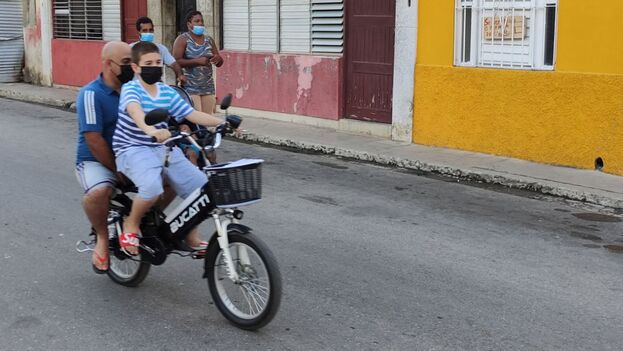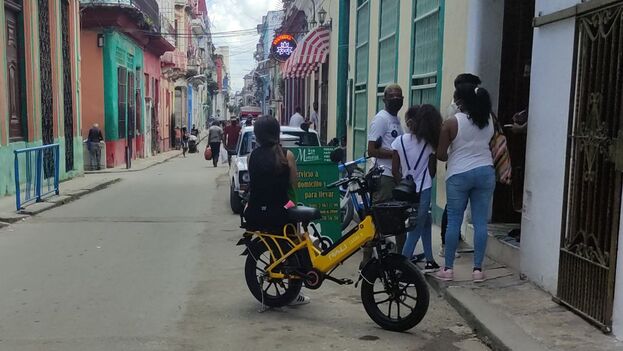
![]() 14ymedio, Juan Diego Rodríguez, Havana, 19 October 2021 – The curious and potential buyers arrived this week at the store that only takes payment in freely convertible currency (MLC) on Infanta Street, in Centro Habana, to see the new electric bicycle marketed by the State.
14ymedio, Juan Diego Rodríguez, Havana, 19 October 2021 – The curious and potential buyers arrived this week at the store that only takes payment in freely convertible currency (MLC) on Infanta Street, in Centro Habana, to see the new electric bicycle marketed by the State.
Gone are the days of the hated Chinese bicycles of the Special Period. Now electric bicycles are in fashion but their price is not within the reach of most Cubans. With a price of 770 dollars (more than 60,000 pesos at the parallel exchange), the LT 4209n is a luxury item in a country of relentless scarcity, but it is an economical alternative to electric motorcycles, called ‘motorinas’, which cost approximately double — up to $2,000 USD in pages like Revolico. The motorinas have reigned in the streets of Cuba in recent years due to the insufficient public transportation system, the shortage of gasoline, the job opportunities they offer and their easy handling.
“Even if I had had enough money to buy a motorina, I would have bought the bicycle anyway,” explains Ernesto, the owner of one of these items, speaking to this newspaper from Sancti Spíritus. He is delighted with his acquisition. “It is cheaper to maintain and, for that matter, it solves the same problem as a motorina: it is for short trips, just like the bicycle. I even carry my wife behind me on mine, without any problems.”
“The motorina serves the same needs as a bicycle, with either one you can move from here to there,” he said.
In addition, Ernesto continues, the parts are also cheaper and when they break down it costs less to change them. “It is not the same to buy a battery for these, which are small, unlike the one for a motorcycle. And it is not the same to buy a tire for a bicycle as it is for a motorina.”
In early September, the company Caribe Electric Vehicles (Vedca), in charge of assembling the bicycle for sale on Infanta Street on the island, published the first images of the model on its social networks and other digital platforms. During those days, Yuniel admits that he “had his eye” on these cycles, but gave up buying one due to the rise in the exchange rate for in the black market (76 pesos for 1 dollar this Thursday) and the increase in food prices.
Yuniel, age 30, had a plan to get a courier license and look for a way to earn extra money, especially since, at the moment, the Traffic authorities do not require a helmet or a driver’s license to ride this kind of bicycle. Many private businesses in Havana, such as restaurants and pizzerias, hire self-employed people with motorcycles and electric bicycles to make home deliveries.
“In addition, bicycles are easier to store and park,” a Centro Habana delivery woman who bought her electric bicycle abroad told 14ymedio. “And they go a long way, 55 kilometers, similar to a motorina,” she adds about the autonomy of the vehicle.
The technical description of the brand-new model LT 4209 indicates that it has a 600-watt motor, that its battery is lithium, that reaches a speed of up to 30 km/h and that it has a range of 65 kilometers and a weight of 35 kilograms.

Luis Alberto, on the other hand, is one of the Cubans who prefer electric motorcycles even though they are much more expensive, but he knows that on the island it is not recommended to buy any of these vehicles that are sold in state stores and assembled in Cuba.
“They are low-cost, the batteries, the motor and the regulator box have poor quality. You see it and say: ‘how beautiful’, but they are just facades. You better think well before investing your money in them,” warns this Havanan, who belongs to the Club Moto Eléctrica Cuba. Luis Alberto ordered a motorina for $ 2,000 from an acquaintance who went shopping in Panama last year and insists that he does not regret the “investment.”
Like Vedca, another entity that is dedicated to the commercialization of electric cycles is the Ángel Villareal Bravo Industrial Company, from Villa Clara, known as Minerva. Several models of electric bicycles of this brand, assembled on the island, were among the first to be sold in the network of state stores, about four years ago.
The prices then ranged from 850 to 1,375 CUC, recalls from Sancti Spíritus another fan of these vehicles, Miguel. “The most expensive electric bicycle had a screen one centimeter high and three wide that marked the mileage,” he details. “With the advantage that I have never heard that an electric bicycle battery has exploded”, he says, referring to the frequent cases of motorina fires due to the manipulation of their electrical system.
However, Miguel has defined very well the differences between a motorcycle and an electric bicycle.” Motorinas operate at a much higher speed, while this type of bicycle reaches a maximum of 30 kilometers per hour.”
Despite this, electric bicycles are beginning to proliferate everywhere on the streets of the Cuban capital. Vedca, which began operating last year in the Mariel Special Development Zone, is one of the brands most promoted in recent months by the Government and sells electric vehicles ranging from 700 to almost 4,000 MLC.
There are more than a few complaints from Cubans, yes, about prices. “Why is everything [only sold in hard currency] in MLC? Do they pay [wages] in that currency in this country?” Asked a user commenting on a Vedca publication on his social networks where it announced the price of the bicycle. “I am an honest worker and my salary is 2,500 pesos a month. In what year could I buy this type of motor?”
According to official data, in the country there are about 300,000 electric bicycles and motorcycles, between imported and marketed within the island, and a third of that figure is in Havana.
____________
COLLABORATE WITH OUR WORK: The 14ymedio team is committed to practicing serious journalism that reflects Cuba’s reality in all its depth. Thank you for joining us on this long journey. We invite you to continue supporting us by becoming a member of 14ymedio now. Together we can continue transforming journalism in Cuba.
